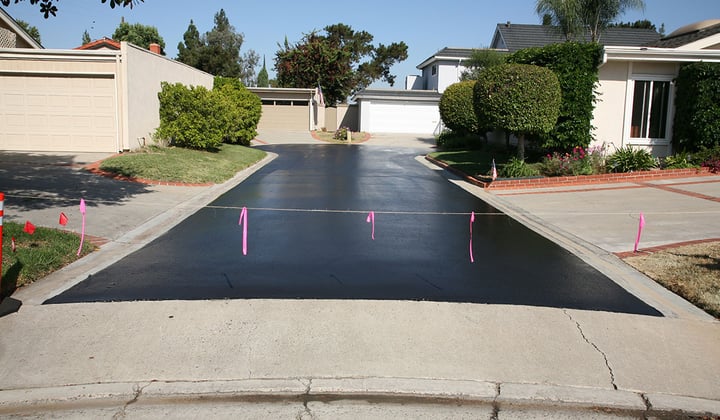Rejuvenate Your Building with Regrading and Asphalt Sealing Techniques
Rejuvenate Your Building with Regrading and Asphalt Sealing Techniques
Blog Article
Warm Mix Asphalt: A Lasting Service for Sidewalk
Hot Mix Asphalt (HMA) has become a leading sustainable selection for pavement services, providing a myriad of ingenious technologies and environmental benefits. Its capacity to reuse materials and minimize power consumption provides a compelling case for its adoption in road building projects. Furthermore, the long-term efficiency and resilience of HMA make it a favored alternative for facilities development. As the demand for environment-friendly building and construction practices grows, exploring the subtleties of HMA's sustainability can supply useful understandings into the future of sidewalk solutions.
Environmental Benefits of Hot Mix Asphalt

Furthermore, Hot Mix Asphalt aids to reduce city heat island impacts. Its dark color soaks up sunshine, decreasing the amount of warm mirrored back into the ambience compared to lighter-colored pavements. This can lower ambient temperatures in urban locations, decreasing the demand for a/c and inevitably reducing power intake.
In addition, Warm Mix Asphalt adds to enhanced stormwater administration. Its porous nature allows water to infiltrate the pavement and reenergize groundwater products, decreasing overflow and the threat of flooding. These ecological benefits make Hot Mix Asphalt a lasting choice for leading roadways and freeways.
Energy Efficiency in HMA Production
Is energy effectiveness a crucial variable in the manufacturing of Hot Mix Asphalt (HMA)? Energy plays a considerable function in the production of HMA, impacting both cost and environmental sustainability. One key element of energy efficiency in HMA production is the usage of warm mix asphalt (WMA) technologies.
In addition, developments in plant innovations have led to even more energy-efficient HMA manufacturing processes. By maximizing energy use in HMA manufacturing, the industry can minimize its carbon impact while maintaining high-quality pavement materials.
Recyclability of Warm Mix Asphalt
The recyclability of Warm Mix Asphalt (HMA) is a crucial facet of its sustainability and long-term ecological effect. HMA is just one of the most recycled products in the United States, with over 100 million lots of redeemed asphalt sidewalk (RAP) being recycled every year in brand-new pavement construction. Reusing HMA supplies several environmental advantages, such as reducing the requirement for virgin products, decreasing energy usage throughout manufacturing, and lowering the quantity of waste sent to landfills.
The procedure of recycling HMA entails milling the existing sidewalk, crushing it right into smaller items, and blending it with brand-new aggregate more information and asphalt binder to create a recycled mix. This recycled mix can commonly perform in addition to and even better than conventional HMA, while calling for fewer raw materials and producing reduced greenhouse gas emissions. By incorporating RAP into new pavement projects, roadway companies can preserve natural deposits, minimize expenses, and minimize the environmental impact of road building and maintenance activities. On the whole, the recyclability of HMA plays a substantial function in promoting sustainable techniques within the look at this website pavement industry.

Long-Term Performance of HMA
Asphalt sidewalks show sturdiness and strength over a prolonged duration, mirroring the long-lasting efficiency of Hot Mix Asphalt (HMA) The longevity of HMA can be associated to its ability to hold up against heavy traffic loads, harsh weather conditions, and the effects of aging. Researches have revealed that properly designed and effectively created HMA sidewalks can last for two decades or even more with normal upkeep. The secret to making best use of the lasting efficiency of HMA exists in utilizing top notch materials, complying with best methods in building and construction, and applying reliable maintenance techniques. Appropriate drain, regular assessments, and timely repairs are essential for maintaining the architectural stability of HMA pavements over time. In addition, improvements in HMA innovation, such as making use of polymer-modified binders and warm mix asphalt, have better boosted the sturdiness and longevity of HMA sidewalks. By prioritizing top quality building and construction and maintenance techniques, HMA proceeds to prove itself as a cost-efficient and lasting solution for resilient pavement framework.

HMA: Sturdiness and Sustainability
Demonstrating both longevity and sustainability, Warm Mix Asphalt (HMA) has become a keystone in the building of long-lasting sidewalk infrastructures - commercial parking lot paving. HMA's toughness stems from its ability to hold up against heavy lots, severe climate condition, and high web traffic volumes, making it a trusted option for roads, freeways, and flight terminal runways. The structure of HMA, which generally consists of accumulations, binder, and filler, plays a vital role in boosting its longevity and resistance to use and tear
Furthermore, HMA's sustainability exists in its recyclability and energy-efficient production process. The capability to recycle redeemed asphalt pavement (RAP) in new HMA blends minimizes the demand for virgin materials and lessens the ecological impact of pavement building and maintenance. Furthermore, the energy efficiency of creating HMA hinges on its reduced blending temperature levels compared to other pavement products, bring about decreased energy usage and greenhouse gas exhausts.
Verdict
In final thought, hot mix asphalt (HMA) supplies a lasting service for sidewalk with its eco pleasant qualities. HMA's recyclability, energy performance in manufacturing, and long-term resilience make it an eco-friendly choice for roadway building and construction.
HMA is one of the most recycled materials in the United States, with over 100 million loads of recovered asphalt pavement (RAP) being recycled every year in new sidewalk building and construction.The process of reusing HMA includes milling the existing sidewalk, crushing it right into smaller items, and mixing it with brand-new aggregate and asphalt binder to develop a recycled mix.Asphalt pavements show sturdiness and resilience over a prolonged period, reflecting the lasting performance Continue of Warm Mix Asphalt (HMA) Additionally, improvements in HMA technology, such as the use of polymer-modified binders and cozy mix asphalt, have even more improved the toughness and durability of HMA pavements. The capability to reuse redeemed asphalt pavement (RAP) in new HMA combinations decreases the need for virgin products and reduces the ecological impact of pavement building and construction and maintenance.
Report this page